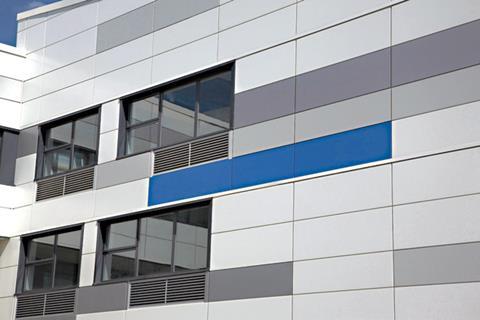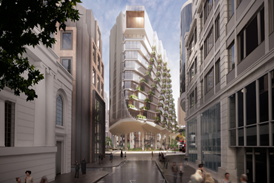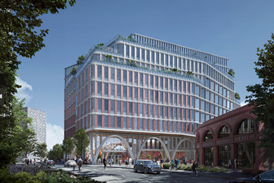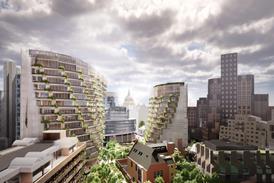This CPD aims to provide a closer understanding of the use of composite panels and unitised components in building facade construction. This CPD module is sponsored by Qbiss by Trimo.
Click here to take the CPD module.
How to use this module: BD Reviews’ free continuing professional development distance learning programme is open to everyone who wants to develop and improve their professional knowledge and skills. These modules can contribute to your annual programme of CPD activity to help you maintain membership of professional institutions and bodies. All you have to do is read this module then take the questions via the link above or at the bottom of the page.
Module 8 deadline: August 26 2011.
Introduction
Unitised components are complete building elements, normally facades, which are factory assembled and joined together on site. A composite panel or a unitised facade provides a complete fully insulated external and internal wall solution, which ensures factory quality standards with minimal site time. Both are self-spanning, which removes the requirement for a secondary support structure.
The only dimensional limitation on a unitised facade is whether it can be transported. A typical assembly is around 6-7m by 3.5m.
The development of integrated facades began with CLASP and the development of composite panels, which then developed into modular or unitised facades.
Development of unitised facades
Composite construction is the bonding together of layers of materials to form a rigid structure. Composite construction methods were introduced after the Second World War, following technological breakthroughs during the conflict. For example, the mosquito bomber was the first aeroplane to use plywood composite construction.
Early composite cladding panels used tension to separate the inner and outer skins, with an insulating layer of air in the middle. One of the first such structures was the Maison du Peuple at Clichy in France, designed by Jean Prouvé
and constructed between 1935 and 1938.
One of the first steps towards a unitised solution was the Consortium of Local Authorities Special Programme (CLASP), established in 1957 to explore modular and factory-produced building products and systems, to provide a systematic form of construction which relied on a high proportion of prefabricated elements.
But manufacturers of these early composite facades did not have the technology to make it work or sufficient under-standing of thermal expansion variants or the need to prevent cold bridging. As a result, weathering was always a major problem as the coefficients of expansion of the different interfacing materials was never considered. This resulted in many of the buildings leaking, with bad water ingress. Condensation was another issue as many of the buildings had no thermal breaks. Basic system design for glazing in the 1950s and 1960s tried to stop water at the front face. Today’s water management detailing lets a degree of water into the front of the system and channels it back out again.
Curtain walling in the 1960s and 1970s was the second generation of composites. Systems were still very basic, used more often as infills rather than to take advantage of their self-spanning characteristics. Early curtain walling had no thermal break, and there was no true integration of glazing and cladding or consistency of detailing.
Glazing and cladding continued to develop independently throughout the 1980s, but two buildings had a huge impact on facades. Renault’s UK headquarters at Swindon, designed by Foster & Partners, was one of the first to feature self-spanning cladding and planar glazing, though there was still no integration. The building is perhaps most remembered for the high-tech appearance of its exposed yellow masts, but their contribution to the structure was much more than
cosmetic.

The client asked for a high degree of free and uninterrupted space within the building, so the roof was suspended to provide greater spans with fewer supporting central columns, and the facade columns were external to provide flush interior walls. Meanwhile, at the Sainsbury Centre at the University of East Anglia, also by Foster’s, the first fully integrated panels, glazing and louvres for walls and roof were installed.
By the turn of the millennium, manufacturers had begun to combine glazing and cladding in the first generation of unitised curtain walls, with external rainscreens. Rain-screens became popular principally due to their more attractive recessed joints and easier glazing interfaces, although integration was still limited to spandrel infills or rainscreens on spandrels. Poor workmanship in joining the two elements also led to many problems.
Only in recent years has there been a more holistic approach to the design of facades, with systems being developed to incorporate the latest technology from both the cladding and glazing sectors. Some of the composites available today offer a total wall solution with bespoke thermal performance, they are non-combustible and self-spanning, and they have recess or flush joints and unique corners.
Joints are particularly important in a facade solution because they are one of the most striking elements. The aesthetics and functionality of the joints of a system can make the difference between an elegant interface detail and a crude flashing or “top hat” cover.
The following quote by Peter Rice, the structural engineer on the Pompidou Centre in Paris, expresses this well: “The dominant memory was the importance of detail. Beaubourg [as the centre is known, after its location] was big, enormous really, but the joint became the central element of the design, making the joint the essence of the solution.”
Manufacturing unitised facades
The process of manufacturing unitised facades is highly automated. For Trimo facades, all raw materials are delivered to an automated handling high bay warehouse. A computer programme identifies the materials required for the project and a driverless vehicle picks up the materials and delivers to the production line.
The materials are automatically loaded into the line feeders and the materials are then assembled together. Some processes, such as the rounded corners for QbissOne products or the gas chambers for QbissAir products are manufactured by robots to ensure high-speed production and consistent quality.
As the finished products come off the line, they go through an automated wrapping and packing process and are then collected in another high bay warehouse to await transport to site. The whole process is fully automated/robotised with minimal manual labour.
Ensuring weathertightness in facade specification
The Centre for Window and Cladding Technology’s CWCT Standard allows the specifier to state the required performance for weathertightness.
For wind load, tests are normally carried out for design wind loads up to 2400Pa. To assess resistance to wind load the design wind load is applied in both positive and negative directions and the wall is required to remain serviceable after application of the design wind load.
A safety wind load test is also carried out at 1.5 times the design wind load after which weathertightness may be impaired but no components should be dislodged during the test.
Watertightness may be carried out at Standard test pressures up to 600Pa. All walls are subject to test under static pressure but walls can also be tested under dynamic pressure.
Trimo’s facade products have been tested for wind resistance under a design wind pressure of 2400Pa and for watertightness under a dynamic pressure equivalent to 600Pa.
A hose test can be used as a site test for watertightness which is intended to check the workmanship of site installation. The test uses a specified type of nozzle which should deliver a spray of 22litres/minute when supplied by water at 220kPa.

Advantages of modern systems over historic facades
Products manufactured under factory conditions should always achieve higher levels of quality, tolerance and finish and reduce site time to a minimum.
Today’s products are designed with a much greater understanding of thermal expansion, cold bridging, suitability of interfacing materials and life expectancy.
All materials expand at different rates, so by establishing the different coefficients of different materials, an informed decision can be established of how the joint between different materials will react under thermal expansion and can be designed to accommodate the thermal differential.
Use of innovative technologies and materials also offers improvements in performance and sustainability. For example, QbissAir panels use air as an insulant.
This does not have the environmental impacts associated with the production of common insulants such as polyurothanes or polyisocyanurates.
The carbon footprint for a typical curtain wall in the UK is usually estimated at around 80-85kgCO2/m3. The carbon footprint of QbissAir is 42kgCO2/m3, and the U-value of the whole modular unit is 0.24W/m2K.
Specifying unitised facades
There are a number of considerations for architects when specifying unitised facades. The most important is consistency of elements.
To ensure modular or unitised facades are the correct choice of facade, there should be a consistency of module dimensions and a reasonable quantity of the same type of module. This ensures volume manufacture is possible, enabling economies of scale.
Specifiers should also:
Understand and work to material parameters – understand the materials, their maximum and minimum dimensions, and how they can be manipulated.
Understand and work to production parameters – visit the factory and understand how the product is made. This can avoid designing unsuitable and impractical details.
Understand and optimise the products’ capability – understand how to maximise the products’ performance.
Understand how specials affect the cost plan – this is a technical and cost issue which is often not understood.
Understand economies of scale -- understand the pricing structure of the product and how some minor alterations can greatly increase the cost.
Postscript
To complete this CPD, read the module and click here to take the test online. If you experience any problems viewing the test online, contact bdreviews.cpd@ubm.com
MODULE 8 DEADLINE: August 26 2011
For more information, go to www.trimo.org.uk
Privacy policy
Information you supply to UBM Information Ltd may be used for publication and also to provide you with information about our products or services in the form of direct marketing by email, telephone, fax or post. Information may also be made available to third parties.
“UBM PLC” may send updates about BD CPD and other relevant UBM products and services. By providing your email address you consent to being contacted by email by “UBM Information Ltd” or other third parties.
If at any time you no longer wish to receive anything from UBM PLC or to have your data made available to third parties, please write to the Data Protection Coordinator, UBM PLC, FREEPOST LON 15637, Tonbridge, TN9 1BR, Freephone 0800 279 0357 or email ubmidpa@ubm.com















1 Readers' comment